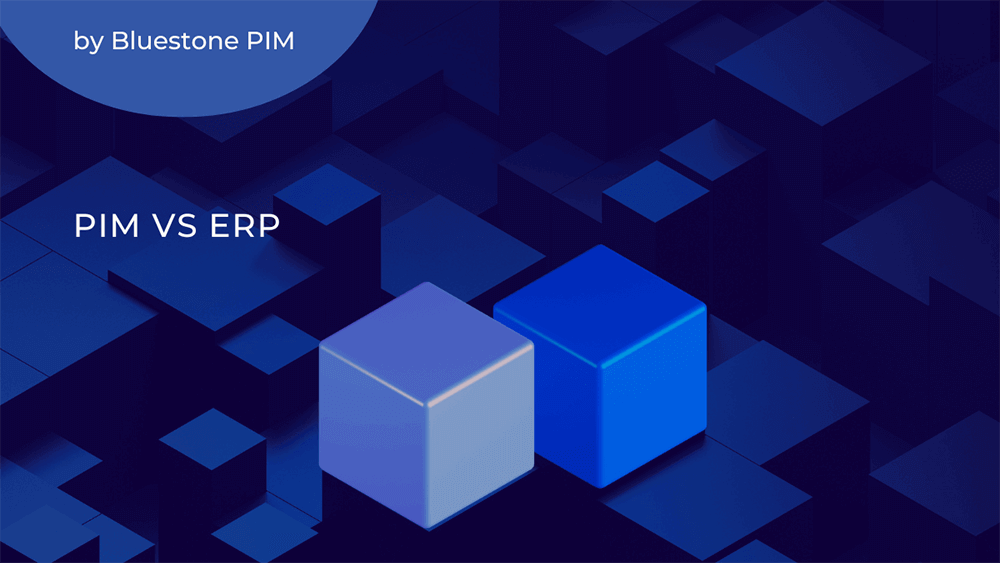PIM or ERP: Which Do You Need for High-Quality Product Data?

High-quality, reliable product data is the lifeblood of every retail and eCommerce company.
For many established companies, ERP has long been a trusted ally in working with this data. However, the shift towards omnichannel customer engagement has brought attention to the need to present products in the competitive online market with accuracy, speed, and flair.
This realization often leads to the exploration of PIM as a potential solution, adding another term to the sea of acronyms and causing confusion for many stakeholders.
In this article, we'll walk you through what PIM and ERP are and what they can do. And we'll show you how to find the best tool to manage your important product data.
What is Enterprise Resource Planning?
Enterprise Resource Planning (ERP) is business management software that integrates various core processes and functions in a company into a unified system. It serves as a comprehensive solution with a single database to streamline front-end and back-end operations, from finance and human resources to supply chain and order fulfillment.
In the words of Shopify:
An ERP system can take orders from customers, manage financial records, update inventory after each sale, and anticipate labor needs based on the level of orders received. In addition to managing processes, ERP systems also gather, store, and analyze data from internal functions, such as marketing, manufacturing, accounting, facilities, and research and development.
The multifaceted capabilities of ERP have made it a cornerstone for many companies. Not only does it serve as a central hub to efficiently manage the intricacies of various tasks, but it also plays a crucial role in orchestrating a smooth flow of data, not only within its own system, but also to other key business platforms such as Customer Relationship Management (CRM) or Order Management Systems (OMS).
The best-known ERP systems include SAP, NetSuite, Microsoft Dynamics, Visma, Dynamics NAV, Infor M3 and Epicor ERP.
What is Product Information Management?
Product information management (PIM) is a comprehensive approach for companies to gather, manage, and optimize their product-related data, e.g., product metadata, technical specifications, digital assets, and translated content.
Like ERP, PIM starts with centralizing data, but it's about more than just storing data. It's also about maintaining data quality, creating complete, compelling product content, and publishing consistent, up-to-date information across all sales and marketing channels.
While the various tasks of PIM can be done by hand, it can be time-consuming, labor-intensive, and error-prone, making it impractical for companies with thousands of SKUs in their product catalog.
Instead, many rely on a dedicated, robust PIM solution. Not only can it act as the authoritative source for all product information, but it also has features that ensure data consistency, facilitate cross-functional collaboration between different departments, and customize product information for different platforms, to name a few.
Companies that have opted for a PIM solution have the following options:
-
Develop an in-house solution
-
Utilize enterprise software with integrated PIM features
-
Opt for a stand-alone PIM solution
As the development of an in-house solution is resource-intensive and enterprise software such as ERP only has limited PIM features, the most prudent choice often leans towards adopting a dedicated PIM solution.
What Is the Difference Between PIM and ERP?
Since both PIM and ERP can process product data, people tend to confuse one with the other, which is why we sometimes get questions like, "If ERP can process product data, why do I need PIM at all?"
Similar to another common question we get about PIM and MDM (Master Data Management) and CMS (Content Management System), this common confusion has prompted us to break down these systems and examine their unique roles.
What Can PIM Do That ERP Cannot?
A PIM solution is dedicated exclusively to the management and optimization of product-related data.
To this end, they have advanced features not normally found in ERP systems, such as product enrichment tools, digital asset management, catalog creation, and product content collaboration, to name a few.
These unique features allow companies to execute a swift go-to-market strategy and bring their products to the online market in a timely manner and with consistent product content, as product data is mapped in detail and prepared for export and syndication across multiple channels.
In contrast, ERP systems require product information to be prepared and compiled individually for each channel, which is a time-consuming and resource-intensive process.
What Does ERP Offer That PIM Does Not?
ERP stands out for its ability to oversee, consolidate, and streamline data from a variety of business functions such as finance, human resources, and supply chain — areas beyond the scope of PIM — and support enterprise-wide operations that go beyond selling or marketing products.
It is this broader focus that distinguishes ERP as a solution that meets diverse business needs, as opposed to PIM's specific niche role in managing product information.
Can You Use PIM and ERP Together?
Yes, and it can be a game-changer for your business.
ERP is the powerhouse that drives the entire machinery of your business and excels at monitoring key front-end and back-end business operations. However, when it comes to enriching and preparing products for digital commerce, it is less efficient and reliable.
If your goal is to publish complete product content on customer-facing platforms and capture customer attention, ERP alone cannot accomplish this task, but together with PIM, it can.
PIM ensures that all important data is present and accurate to create a comprehensive and compelling presentation of your products. It extracts relevant product information from the ERP and uses it to enrich your products with data such as:
-
SEO-optimized product descriptions
-
High-quality images and videos
-
Product metadata (attributes, variants, SKUs, etc.)
-
Product hierarchy
-
Technical specifications
-
Downloadable documents
-
Customer reviews and testimonials
-
Domestic and international pricing information
-
Localized and regionalized content
Both PIM and ERP can work harmoniously in your business landscape, rather than the functions clashing. Each has its own strengths, and their integration does not dilute their individual potential. Rather, synergies are created that help your company offer your customers a seamless and consistent shopping experience across all touchpoints through rich and detailed product content.
So leave it to ERP to manage the backend operations of your business, and let PIM bring your products to life.
Maximize Your Retail and eCommerce Potential with Bluestone PIM
If product information management is a priority now or in the future, then investing in a robust PIM system is a strategic imperative.
Bluestone PIM is the epitome of a best-of-breed PIM solution, built on the MACH architecture — a composable commerce approach to developing scalable, flexible, and future-proof software that meets the complex and ever-evolving needs of modern commerce.
Adapt your tech stack to the needs of your business, integrate it effortlessly with other systems and business platforms, and ensure a seamless and personalized digital customer experience at all touchpoints.
Whether you need PIM as a standalone solution or want to integrate it with your ERP system, Bluestone PIM is the ideal solution to help your business drive online multichannel sales though the creation and delivery of high-quality, reliable product data.
Are you ready to experience the transformative power of Bluestone PIM in action? Contact our PIM advisors today for a free consultation or book a demo meeting to experience the features of Bluestone PIM first-hand.
Editor’s note: This post was originally published in March 2020 and has been updated with the latest information.




